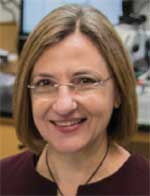LAURA MARCU, UNIVERSITY OF CALIFORNIA, DAVIS
During surgical procedures, it is imperative to rapidly distinguish between cancer and surrounding healthy tissue and to determine where and how much tissue to cut. To improve a patient’s survival rate and quality of life, surgeons must strike a balance between minimizing the possibility of the tumor recurring by removing all cancerous tissue and maximizing organ preservation and function by avoiding unnecessary removal of normal tissues.
Current methods used to ensure surgical margins and adequate tumor removal are limited. Typically, they are based on a surgeon’s visual inspection, palpation and intraoperative frozen section pathology. The process is time-consuming, expensive, prone to inaccuracy and at risk of sampling error.
While imaging techniques such as computed tomography (CT), positron emission tomography (PET), magnetic resonance imaging (MRI) and ultrasound have played an important role in preoperative diagnostics, these techniques are sparsely used intraoperatively. CT and PET are not compatible with intraoperative settings as they make use of ionizing radiation. Intraoperative MRI requires specialized operating rooms, and most intraoperative ultrasound systems lack sufficient resolution.
Several clinical applications have demonstrated that optical molecular imaging can serve as a powerful intraoperative tool for guiding surgeons performing surgical interventions, including robotic procedures. The integration of the FireFly module into the da Vinci Surgical System, for example, represented a paradigm shift in surgical navigation when introduced in 2010. This module makes use of near-infrared fluorescence (NIRF) imaging to visualize blood flow and related tissue perfusion employing indocyanine green (ICG) as the fluorescent agent.
Image-guided surgery based on exogenous molecular contrast encompasses its own limitations. This includes the need for dose optimization and timing and the limited number of molecular probes approved for use in humans. Despite significant efforts over the past two decades in the development of new optical molecular probes, very few have been approved for human use.
Label-free optical techniques offer the capability to assess morphological features and functional and molecular tissue characteristics associated with distinct pathophysiological conditions. Although such techniques require a priori understanding of endogenous contrast mechanisms and may be subject to a low signal-to-noise ratio, label-free optical contrast offers real-time tissue characterization and diagnosis during clinical procedures. Tissue autofluorescence properties, in particular, provide the means to evaluate biochemical and metabolic changes in biological tissues.
There is an increased interest in using autofluorescence lifetime contrast as a means for intraoperative diagnostics and surgical guidance. Lifetime measurements are independent of fluorescence intensity. They can overcome the limitations encountered by conventional intensity measurements such as the variation in fluorescence excitation-collection geometry and attenuation of light absorption by blood within tissue. However, to measure and analyze the autofluorescence signal, lifetime-based techniques require complex instrumentation and computational methods that have hampered clinical adoption.
With the advent of new laser light sources and fast detectors and electronics, high-performance and ergonomic fluorescence lifetime imaging systems can be engineered at lower cost and be compatible with clinical environments. A variety of fluorescence lifetime instrumentation has evolved and is being used experimentally. This ranges from single-channel (point) spectroscopy utilizing ultrafast sampling and time-correlated single-photon counting systems to fluorescence lifetime imaging microscopy (FLIM) based on time-gated imaging cameras.
A clinically compatible FLIM technique has been developed in my laboratory. It is being evaluated in patients undergoing surgery for tumor removal as a tool for intraoperative real-time diagnostics, surgical guidance and augmented reality.
The FLIM system is based on a point-spectroscopy time-resolved pulse-sampling technique that can simultaneously resolve and display fluorescence decay (lifetimes) characteristics from multiple spectral channels in less than 1 μs per data point. The FLIM image is constructed by scanning a fiber optic probe above the area of interest. A recent feature allows us to augment the computed fluorescence lifetime features on the white-light images of the surgical field of view and to track the tissue’s maximum permissible exposure to laser excitation.
Ongoing studies include real-time delineation of surgical margins in head and neck cancer during trans-oral robotic surgery and brain tumor and radiation necrosis during craniotomy procedures. Recent work has demonstrated the applicability of our technique to the detection of positive margins during breast-conserving surgery. While large clinical trials are needed, current findings show that FLIM-derived parameters allow for delineation of tumor from surrounding normal tissue and for resolving biochemical heterogeneity within a distinct tissue type.
In my view, the translation of fluorescence lifetime technique into clinical practice is no longer hampered by technological barriers, but rather by our limited ability to validate the endogenous fluorescence signals against gold-standard techniques. Conventional histopathology primarily evaluates tissue morphology rather than metabolism or physiology. Pathophysiological features potentially detected by label-free fluorescence techniques cannot be fully confirmed. There is a compelling need for means to validate the autofluorescence contrast to accelerate the adoption of autofluorescence lifetime techniques that have the potential to improve the surgical outcome and the patient’s quality of life.

Meet the author
Laura Marcu is professor of biomedical engineering and neurological surgery and head of the Biophotonics Laboratory at the University of California, Davis. Her research interests include the development of optical spectroscopy and imaging technologies, with emphasis on image-guided interventions, intravascular diagnostics and regenerative medicine. She is a fellow of OSA, SPIE, AIMBE, BMES and NAI; email: [email protected].